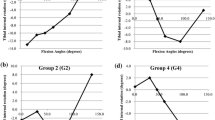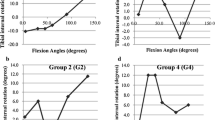Abstract
Purpose
Recently, the functional flexion axis has been considered to provide a proper rotational alignment of the femoral component in total knee arthroplasty. Several factors could influence the identification of the functional flexion axis. The purpose of this study was to analyse the estimation of the functional flexion axis by separately focusing on passive flexion and extension movements and specifically assessing its orientation compared to the transepicondylar axis, in both the axial plane and the frontal plane.
Methods
Anatomical and kinematic acquisitions were performed using a commercial navigation system on 79 patients undergoing total knee arthroplasty with cruciate substituting prosthesis design. The functional flexion axis was estimated from passive movements, between 0° and 120° of flexion and back. Intra-observer agreement and reliability, internal–external rotation and the angle with the surgical transepicondylar axis, in axial and frontal planes, were separately analysed for flexion and extension, in pre- and post-implant conditions.
Results
The analysis of reliability and agreement showed good results. The identification of the functional flexion axis showed statistically significant differences both in relation to flexion and extension and to pre- and post-implant conditions, both in frontal plane and in axial plane. The analysis of internal–external rotation confirmed these differences in kinematics (p < 0.05, between 25° and 35° of flexion).
Conclusions
The identification of the functional flexion axis changed in relation to passive flexion and extension movements, above all in frontal plane, while it resulted more stable and reliable in axial plane. These findings supported the possible clinical application of the functional flexion axis in the surgical practice by implementing navigated procedures. However, further analyses are required to better understand the factors affecting the identification of the functional flexion axis.
Level of evidence
IV.




Similar content being viewed by others
References
Aglietti P, Sensi L, Cuomo P, Ciardullo A (2008) Rotational position of femoral and tibial components in TKA using the femoral transepicondylar axis. Clin Orthop Relat Res 466:2751–2755
Amis AA, Senavongse W, Bull AMJ (2006) Patellofemoral kinematics during knee flexion–extension: an in vitro study. J Orthop Res 24:2201–2211
Asano T, Akagi M, Nakamura T (2005) The functional flexion–extension axis of the knee corresponds to the surgical epicondylar axis: in vivo analysis using a biplanar image-matching technique. J Arthroplasty 20:1060–1067
Bartlett JW, Frost C (2008) Reliability, repeatability and reproducibility: analysis of measurement errors in continuous variables. Ultrasound Obstet Gynecol Off J Int Soc Ultrasound Obstet Gynecol 31:466–475
Blankevoort L, Huiskes R, De Lange A (1990) Helical axes of passive knee joint motions. J Biomech 23:1219–1229
Cole GK, Nigg BM, Ronsky JL, Yeadon MR (1993) Application of the joint coordinate system to three-dimensional joint attitude and movement representation: a standardization proposal. J Biomech Eng 115:344–349
Colle F, Bignozzi S, Lopomo N, Zaffagnini S, Sun L, Marcacci M (2012) Knee functional flexion axis in osteoarthritic patients: comparison in vivo with transepicondylar axis using a navigation system. Knee Surg Sports Traumatol Arthrosc 20:552–558
Colle F, Lopomo N, Bruni D, Visani A, Iacono F, Zaffagnini S, Marcacci M (2014) Analysis of knee functional flexion axis in navigated TKA: identification and repeatability before and after implant positioning. Knee Surg Sports Traumatol Arthrosc 22:694–702
Dennis DA, Mahfouz MR, Komistek RD, Hoff W (2005) In vivo determination of normal and anterior cruciate ligament-deficient knee kinematics. J Biomech 38:241–253
Doro LC, Hughes RE, Miller JD, Schultz KF, Hallstrom B, Urquhart AG (2008) The reproducibility of a kinematically-derived axis of the knee versus digitized anatomical landmarks using a knee navigation system. Open Biomed Eng J 2:52–56
Eckhoff D, Hogan C, Di Matteo L, Robinson M, Bach J (2007) Difference between the epicondylar and cylindrical axis of the knee. Clin Orthop Relat Res 461:238–244
Ehrig RM, Taylor WR, Duda GN, Heller MO (2007) A survey of formal methods for determining functional joint axes. J Biomech 40:2150–2157
Feng Y, Tsai TY, Li JS, Wang S, Hu H, Zhang C, Rubash HE, Li G (2015) Motion of the femoral condyles in flexion and extension during a continuous lunge. J Orthop Res 33(4):591–597
Grood ES, Suntay WJ (1983) A joint coordinate system for the clinical description of three-dimensional motions: application to the knee. J Biomech Eng 105:136–144
Iacono F, Bruni D, Bignozzi S, Colle F, Marcacci M (2014) Does total knee arthroplasty modify flexion axis of the knee? Knee Surg Sports Traumatol Arthrosc 22(8):1728–1735
Ishida K, Shibanuma N, Matsumoto T, Sasaki H, Takayama K, Toda A, Kuroda R, Kurosaka M (2015) Factors affecting intraoperative kinematic patterns and flexion angles in navigated total knee arthroplasty. Knee Surg Sports Traumatol Arthrosc 23(6):1741–1747
Jenny J-Y, Boeri C (2004) Low reproducibility of the intra-operative measurement of the transepicondylar axis during total knee replacement. Acta Orthop Scand 75:74–77
MacWilliams BA (2008) A comparison of four functional methods to determine centers and axes of rotations. Gait Posture 28:673–679
Maderbacher G, Schaumburger J, Baier C, Zeman F, Springorum HR, Birkenbach AM, Grifka J, Keshmiri A (2015) Appropriate sagittal femoral component alignment cannot be ensured by intramedullary alignment rods. Knee Surg Sports Traumatol Arthrosc. doi:10.1007/s00167-015-3541-8
Martelli S, Zaffagnini S, Bignozzi S, Bontempi M, Marcacci M (2006) Validation of a new protocol for computer-assisted evaluation of kinematics of double-bundle ACL reconstruction. Clin Biomech (Bristol Avon) 21:279–287
Martelli S, Zaffagnini S, Bignozzi S, Lopomo N, Marcacci M (2007) Description and validation of a navigation system for intra-operative evaluation of knee laxity. Comput Aided Surg 12(3):181–188
McGraw KO, Wong SP (1996) Forming inferences about some intraclass correlation coefficients. Psychol Methods 1:30–46
Mihalko WM, Ali M, Phillips MJ, Bayers-Thering M, Krackow KA (2008) Passive knee kinematics before and after total knee arthroplasty: are we correcting pathologic motion? J Arthroplasty 23:57–60
Moon YW, Seo JG, Lim SJ, Yang JH (2010) Variability in femoral component rotation reference axes measured during navigation-assisted total knee arthroplasty using gap technique. J Arthroplasty 25:238–243
Oussedik S, Scholes C, Ferguson D, Roe J, Parker D (2012) Is femoral component rotation in a TKA reliably guided by the functional flexion axis? Clin Orthop Relat Res 470(11):3227–3232
Reichl I, Leichtle U, Lorenz A (2014) Functionally computed flexion axis reduces kinematic interspecimen variation in in vitro experiments. Comput Methods Biomech Biomed Eng 17(Suppl 1):126–127
Siston RA, Patel JJ, Goodman SB, Delp SL, Giori NJ (2005) The variability of femoral rotational alignment in total knee arthroplasty. J Bone Joint Surg Am 87:2276–2280
Siston RA, Cromie MJ, Gold GE, Goodman SB, Delp SL, Maloney WJ, Giori NJ (2008) Averaging different alignment axes improves femoral rotational alignment in computer-navigated total knee arthroplasty. J Bone Joint Surg Am 90:2098–2104
Vanin N, Panzica M, Dikos G, Krettek C, Hankemeier S (2011) Rotational alignment in total knee arthroplasty: intraoperative inter- and intraobserver reliability of Whiteside’s line. Arch Orthop Trauma Surg 131:1477–1480
Victor J (2009) Rotational alignment of the distal femur: a literature review. Orthop Traumatol Surg Res 95:365–372
Wiles AD, Thompson DG, Frantz DD (2004) Accuracy assessment and interpretation for optical tracking systems. In: Proceedings of SPIE Medical Imaging 2004: visualization image-guided procedures, and display, vol 5367, pp 421–432
Wilson DA, Astephen Wilson JL, Richardson G, Dunbar MJ (2014) Changes in the functional flexion axis of the knee before and after total knee arthroplasty using a navigation system. J Arthroplasty 29(7):1388–1393
Woltring HJ, Huiskes R, de Lange A, Veldpaus FE (1985) Finite centroid and helical axis estimation from noisy landmark measurements in the study of human joint kinematics. J Biomech 18:379–389
Acknowledgments
This work was partially supported by the “5×1000” (2012) funding, provided by Istituto Ortopedico Rizzoli, Bologna (Italy). The authors would like to thank Mr. Emil J. “Systemystic” Ferretti for his contribution to the laboratory IT management and the precious Mrs. Silvia Bassini for the graphical support.
Author information
Authors and Affiliations
Corresponding author
Rights and permissions
About this article
Cite this article
Colle, F., Bruni, D., Iacono, F. et al. Changes in the orientation of knee functional flexion axis during passive flexion and extension movements in navigated total knee arthroplasty. Knee Surg Sports Traumatol Arthrosc 24, 2461–2469 (2016). https://doi.org/10.1007/s00167-015-3816-0
Received:
Accepted:
Published:
Issue Date:
DOI: https://doi.org/10.1007/s00167-015-3816-0




